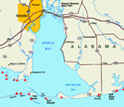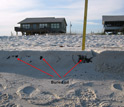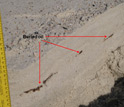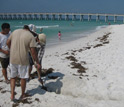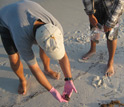News Release 10-108
Gulf Oil Spill: NSF Awards Rapid Response Grant to Study Oil Found on Alabama, North Florida Beaches
Scientists track "beach-fall" of tar balls along more than 99 miles of beach on the northern Gulf coast
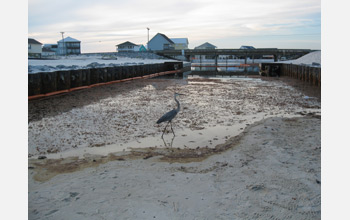
Oil has washed up along miles of Gulf coast beaches, geologists funded by NSF are finding.
June 25, 2010
This material is available primarily for archival purposes. Telephone numbers or other contact information may be out of date; please see current contact information at media contacts.
The first determination of "beach-fall" of oil along the Alabama and northwest Florida beaches has been made, say National Science Foundation (NSF)-funded geologists at the University of South Florida (USF).
Ping Wang and USF graduate students Mark Horwitz, Tiffany Roberts, Katherine Brustche and Jun Cheng report that tar balls have been found along 160 kilometers (more than 99 miles) of the overall 180 kilometers (nearly 112 miles) of beaches the team studied.
Wang received an NSF rapid response grant for the research.
"The baseline information Wang and colleagues have assembled is an invaluable data set for assessing the mixing of oil in beach sands across the Mississippi, Alabama and western Florida shorelines," said H. Richard Lane, program director in NSF's Division of Earth Sciences, which co-funded Wang's rapid response award with NSF's Division of Ocean Sciences.
The researchers studied a stretch of coastline from Alabama's Dauphin Island to the eastern end of Santa Rosa Island in Florida, including 17 sections of northeast Gulf beaches and six marsh areas in the eastern Mississippi Sound.
While crews cleaning beaches along the Gulf coast where oil is washing ashore have become a common sight, Wang said cleanup efforts are leaving behind numerous small tar balls and contaminated beaches.
Although most of the larger tar balls are removed, the cleanup efforts don't return the beaches to their pre-spill condition. The tar balls can become easily buried in the sand, Wang said. Buried oil, he said, is more difficult to remove and may decay more slowly than exposed tar balls.
The findings represent conditions along the studied stretch of coastline through June 9th, and include results associated with varying degrees of beach cleanup.
The intensity of the beached oil decreased generally from west to east, but the study was conducted before wind conditions began moving oil farther east toward more stretches of Florida Panhandle shorelines.
The researchers first traveled the northern Gulf beaches from May 7th-19th to gather baseline data on beach conditions.
These pre-beach-oiling data were collected along pristine beaches in state and national parks, as well as along heavily developed stretches of beach.
In addition to examining the beaches for oil, the scientists conducted short coring operations to get a complete picture of beach conditions before the oil arrived.
On their first research trip in May, the researchers found unsoiled white quartz sand (also known as "sugar sand"), which has made the area's beaches among the world's most famous.
By the time the geologists returned in June, the shores were marked with sticky tar balls, some as large as pancakes.
The strengthening of summer sea breezes will provide stronger on-shore forcing to push the oil onto the beaches, Wang said.
"High waves and storm surges are capable of spreading the oil contamination over a much larger area than the narrow beach zone where the tar balls are currently found," Wang said.
"It doesn't need to be a major hurricane to push the oil onto the shore and spread it over a large area--it just needs to be a storm."
This NSF grant is one of many Gulf oil spill-related rapid response awards made by the federal agency. NSF's response involves active research in social sciences, geosciences, computer simulation, engineering, biology, and other fields. So far, the Foundation has made more than 60 awards totaling nearly $7 million.
-NSF-
-
Beaches sampled by the research team extend across the northern Gulf region.
Credit and Larger Version -
Oil has become mixed with beach sands, what scientists term "beach-fall."
Credit and Larger Version -
A close-up view of oil buried under Gulf coast sands.
Credit and Larger Version -
Geologists Ping Wang and colleagues look beneath the surface of Gulf coast beaches for oil.
Credit and Larger Version -
Ping Wang and research team collect samples of oil they have uncovered along Gulf beaches.
Credit and Larger Version
Media Contacts
Cheryl Dybas, NSF, (703) 292-7734, email: cdybas@nsf.gov
Vickie Chachere, USF, (813) 974-6251, email: vchachere@admin.usf.edu
The U.S. National Science Foundation propels the nation forward by advancing fundamental research in all fields of science and engineering. NSF supports research and people by providing facilities, instruments and funding to support their ingenuity and sustain the U.S. as a global leader in research and innovation. With a fiscal year 2023 budget of $9.5 billion, NSF funds reach all 50 states through grants to nearly 2,000 colleges, universities and institutions. Each year, NSF receives more than 40,000 competitive proposals and makes about 11,000 new awards. Those awards include support for cooperative research with industry, Arctic and Antarctic research and operations, and U.S. participation in international scientific efforts.
Connect with us online
NSF website: nsf.gov
NSF News: nsf.gov/news
For News Media: nsf.gov/news/newsroom
Statistics: nsf.gov/statistics/
Awards database: nsf.gov/awardsearch/
Follow us on social
Twitter: twitter.com/NSF
Facebook: facebook.com/US.NSF
Instagram: instagram.com/nsfgov



